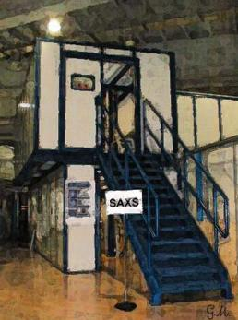Small Angle X-ray Scattering (SAXS)
of TU Graz at Elettra Sincrotrone Trieste
Small Angle X-ray Scattering is a non-destructive and highly versatile standard method to study the nanoscale structure of any type of material, ranging from new composite nanosystems to biological macromolecules. Parameters such as (i) average particle sizes, shapes and distributions, (ii) the materials’ porosity and degree of crystallinity, as well as (iii) electron density maps with nanometer precision, can be obtained. Simultaneously performed Wide Angle X-ray Scattering (WAXS) additionally allows the determination of the degree of crystallinity. Materials can be solid, liquid or even exhibit gaseous-like properties, for instance aerosols.

The highflux SAXS beamline, located at Elettra Sincrotrone Trieste, was mainly intended for time-resolved studies on fast structural transitions in the sub-millisecond time region in solutions and partly ordered systems with a SAXS-resolution of at least 100 nm in real-space. However, increasingly also grazing-incidence (GISAXS) measurements are performed to study self-assembly processes on surfaces or to perform structural characterizations of thin films. Additionally, SAXS measurements can be coupled to simultaneous Differential Scanning Calorimetry (DSC) and Wide Angle X-ray Scattering (WAXS) recordings.
Contact:
Heinz Amenitsch
Tel: +39 040 375 8044 (office) | +39 040 375 8363 (beamline)
Sigrid Bernstorff
Tel: +39 040 375 8572 (office) | +39 040 375 8363 (beamline)
Technical specifications
| Beamline energy resolution: | 2 x 10 x 10-3 @ 8keV |
| Energy range: | 5.4keV, 8keV and 16keV (fixed energy) |
| Maximum flux at sample: | 5 x 10 x 10+12 Ph/s @ 8keV |
| Spot size on sample horizontal: | 20 micron to 4500 micron (variable) |
| Spot size on sample vertical: | 20 micron to 1000 micron (variable) |
| Angle of incident light on sample: | GISAXS or transmission SAXS possible. |
Sample environment
Users have the possibility of using a wide variety of sample holders and environments (e.g. thermostatic capillary holders, rapid mixing devices, inline DSC, T-jump with IR Laser, pressure cell, GISAXS holder etc.) or to install their own specialized equipment. Detailed information can be found on the beamline’s main homepage.
Due to the highly variable kept sample stage, there are almost no limits for the realization of an experiment. You are welcome to propose to our team any interesting and high-lighting investigations for the benefit of materials and life sciences.
-
20.02.2025
X-ray computed tomography (CT) TomoLab
-
23.01.2025
THz beamline TeraFERMI



